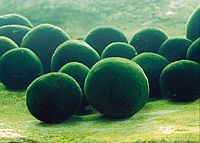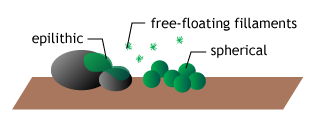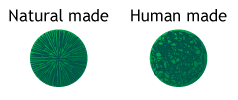Chiba
From 2007.igem.org
(→Why Making "Marimo"?) |
(→Why Making "Marimo"?) |
||
| Line 25: | Line 25: | ||
球体という形では安定する形であるだろうか? | 球体という形では安定する形であるだろうか? | ||
| - | + | ||
| + | 球体という形をとるものはマリモのほかには眼球は球体である。 | ||
| + | |||
| + | また水中では油は球体になり、また水も油の中では球体である。球体に近いもので卵などがあげられる。 | ||
| + | |||
球体の形を取らないのは、バクテリアの細胞や結晶格子、さまざまな生物は球体ではない。 | 球体の形を取らないのは、バクテリアの細胞や結晶格子、さまざまな生物は球体ではない。 | ||
| + | |||
生物でも非生物でも球体を維持するものは少ない | 生物でも非生物でも球体を維持するものは少ない | ||
| + | |||
マリモではなく普通の藻であるならば石の上に生えることが多い | マリモではなく普通の藻であるならば石の上に生えることが多い | ||
| + | |||
自ら動くことができるもので球体でありつづけられるものがあるだろうか | 自ら動くことができるもので球体でありつづけられるものがあるだろうか | ||
| + | |||
マリモは自ら動かないから球体を維持できるのではないか。 | マリモは自ら動かないから球体を維持できるのではないか。 | ||
| + | |||
| + | 自ら動くことのできる大腸菌が球体であり続けることを目指したい。 | ||
| + | |||
| + | |||
| + | 球体であり続けることを応用したものとして3Dコロニーを作れるのではないか? | ||
Revision as of 03:31, 27 October 2007
|
Introduction | Project Design ( 1.Affinity Tag | 2.Communication Module | 3.Size Control ) | Making Marimos | Our Goal |
Introduction
Chiba University iGEM07 team's project is to make a Marimo-ish gathering of bacteria. Marimo is a green spherical shaped algae, which is a popular living organism in Japan as a National Treasure. We borrowed the name Marimo because of its name publicity (maybe only in Japan, which we didn't notice until recently) and their marvelous velvet which charmed us so much. Our motivations for making Marimo bacteria is as follows.
Why Making "Marimo"?
・生物であっても、非生物であっても球体でありつづけるものはすくない ・非生物が外からの力がないときに球体になるものがない ・球体という形は安定? ・藻であったら石に生えることが多い ・自らの意思で動くものに、球体で存在するものがあるだろうか(ないだろう) ・マリモは植物であるからきゅうたいでいられるのではないか ・大腸菌は目的をもって動いている ・それを球体にまとめられたら面白いのではないか ・まとまったものを何かに利用できるそうだ(3Dコロニー) ーーーーーーーーーーーーーーーーーーーーーーーーーーーーーーーーーーーーーー
球体という形では安定する形であるだろうか?
球体という形をとるものはマリモのほかには眼球は球体である。
また水中では油は球体になり、また水も油の中では球体である。球体に近いもので卵などがあげられる。
球体の形を取らないのは、バクテリアの細胞や結晶格子、さまざまな生物は球体ではない。
生物でも非生物でも球体を維持するものは少ない
マリモではなく普通の藻であるならば石の上に生えることが多い
自ら動くことができるもので球体でありつづけられるものがあるだろうか
マリモは自ら動かないから球体を維持できるのではないか。
自ら動くことのできる大腸菌が球体であり続けることを目指したい。
球体であり続けることを応用したものとして3Dコロニーを作れるのではないか?
Making 3D colonies- for next generation (lazier) molecular biologists
For years microbiologists have been using agar plates to isolate cells from each other. By spreading the diluted cells on a solid surface, we can make "colonies", dome-shaped gathering of genetically identical cells. Although convenient, this is only two-dimentional. What if we can create three dimentional (spherical) colonies with controlled/ defined size? Thus we can eliminate the plating process that everybody hates. Combined with the microfluidics devices, we might be able to pick, isolate, count, or innoculate each of the floating yet independent colonies to conduct routine works in future molecular biology. Crazy thought? Well, that is exactly what our advisors say.
Toward the control the population size of the bacteria community
Even in the bacteria community, sometimes they need to do the population control. This is especially so when we think about the chemical production using bacteria robots.
Besides the above illogical/ unjustified reasons, we think this project leads to the behavior control of the bacterial comunity. Lots of challenge in the project including diffusion control of small/ large molecules, chemical production/ degradation balancing,.....
Backgrounds
Marimo?
Marimo is known as a spherical shaped algae which could be found, for example, in the Lake Akan in Hokkaido, Japan. The Lake Akan's Marimo is defined as a Natural Tresure of the country, because of its beautiful velvet and its sphrerical shape.Actually, the name "marimo" indicates the algae filament, not the sphere. The sphere shape is one of the three growth forms of the aggregated marimo fillaments. Another growth form lives as free-floating fillaments as small tufts of unattached filaments that frequently form a carpet on the muddy lake bottom. The third is epilithic (growing on rocks). Marimos are found in some of the lakes in Japan and other countries, but the beautiful spherical shaped marimos are only known in Iceland, Estonia and Japan.
How Marimos are Made
Natural Marimos
Spherical marimos are formed through the growth of a core which is a fragment of ancestral marimos. So when you watch the cross section of the spherical marimo, you do not recognize a core-shell structure in it. How about the most ancestral marimos? It is expected that the most ancestral marimos had a core made of inorganic materials such as cray particles or sand solids.
Artificial Marimos
Marimos are a popular "pet" in Japan. Well, you can't keep the National Tresure as a pet, so they house the artificial one instead. Although the mechanism of how the spherical marimo are made is not known in detail, the alternative method of making marimo have been invented from about 30 years ago by many Japanese scientist/botanist/marimoist.
There are several ways to make artificial marimo, and you can buy the one made these ways at flowershops/ petshops in JPN. However, artificial marimo, or fake marimo, have clear difference from natural ones. When divided in the middle, the artificial marimos show no pattern or any sort of order. One can only see the fillament randomly tangled like a spaghetti. In contrast, natural marimo shows highly ordered structure of algae filaments; all filaments are lined up on an ordered way to form a radial pattern. In addition, the filament density of the core is very low (often nearly zero).References:
- 阪井與志雄,マリモの科学,北海道大学図書刊行会, 1991 (Yoshio Sakai, Marimo no Kagaku("The Science of Marimo"))
- 中沢信午,マリモはなぜ丸い その生態と形態,中公新書,1989 (Shingo Nakazawa, Marimo wa naze marui ("Why marimos are spherical"))



